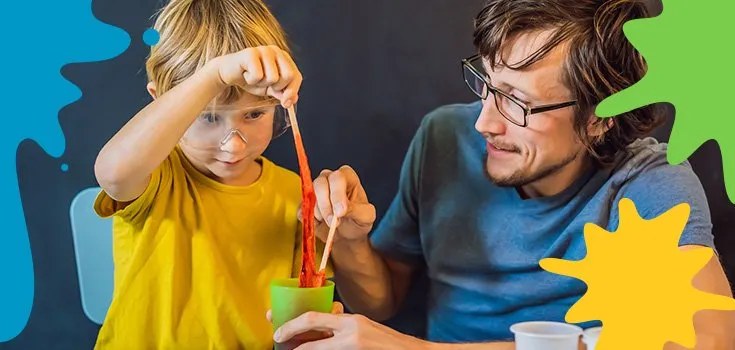Teaching kids just how fun chemistry can be is easy with hands-on learning opportunities! See the instructions below to get everything you need for these easy chemistry experiments.
1. The Best Basic Slime
Who doesn’t like slime? It’s stretchy, easy to make and fun to play with when the lesson’s over! Plus, it demonstrates how polymers and ions interact with an experiment you can see and feel. You’ll need:
- White glue
- Liquid starch
- Food coloring
- A bowl and spoon
How to Conduct the Experiment
Follow these steps to make your own slime:
- Start by pouring 4 ounces of white, all-purpose glue into a bowl.
- Add a few drops of food coloring.
- Slowly pour 2 ounces of liquid starch into the, mixing as you add it.
- Knead the mix with your hands until the slime pulls from the sides.
- When you can lift the slime out of the bowl, continue to knead and stretch it until it becomes stronger.
- Seal in an airtight container.
2. Cloud in a Bottle Experiment
Making a cloud in a bottle is an easy chemistry experiment for kids. A cloud consists of tiny invisible droplets, and this project uses smoke to help you create one inside a bottle. You’ll need:
- A 1-liter bottle and its cap
- Warm water
- A match
How to Conduct the Experiment
Make a cloud in a bottle in a few simple steps:
- Pour warm water into the bottle until you’ve covered the bottom.
- Light a match and place the tip in the bottle, allowing the bottle to fill with smoke.
- Seal the bottle.
- Squeeze the bottle vigorously a few times. A cloud should form in the bottle, and it may disappear while squeezing.
3. DIY Bath Bomb Experiment
Watching a bath bomb fizz brings a smile to anyone’s face. With this experiment, the joy can stretch even farther as the kids can make their own bath bombs and learn about the chemical reaction between citric acid and sodium bicarbonate. You’ll need:
- Food coloring
- Eco-friendly glitter and dried flowers
- Sweet almond oil
- Scented oil
- Baking soda
- Citric acid
- A large muffin tray
- A small glass jar
- Rubber gloves
- Bowls and a spoon
How to Conduct the Experiment
Follow these steps to make your own bath bombs:
- Lightly rub the muffin tray with almond oil.
- Mix 3 tablespoons of citric acid and 10 tablespoons of baking soda in a mixing bowl.
- Pour half of this mixture into another bowl.
- Add the glitter and petals to each of the bowls.
- Add 6 drops of scented oil, 5 teaspoons of sweet almond oil and 9 drops of food coloring in the glass jar.
- Pour the oil mix into the mixing bowls with dry ingredients.
- Wear gloves to combine the oil and dry ingredients until the mixture stays in your hand without crumbling too much.
- Spoon the mixtures into the muffin trays and press down to compact them.
- Leave the bath bombs out to dry for a few days.
- Pop them out of the trays and into the bath for fizzy fun!
4. Water Fireworks Experiment
Real fireworks look spectacular, but there’ll be no explosions here. This underwater fireworks experiment shows that oil is denser than water. The food coloring dissolves in water but not oil, as the oil breaks up the coloring droplets.
What You Need
- A tall, clear glass of warm water
- Oil
- Another glass
- Food coloring
- A fork
How to Conduct the Experiment
Create your own underwater fireworks with these steps:
- Start by filling one tall glass with warm water.
- Pour 1 to 2 tablespoons of oil into the other glass. Add food coloring and gently mix until smaller droplets form.
- Pour the oil into the tall glass of water.
- Time for the fireworks — observe how the food coloring sinks in the glass and each droplet expands to look like a firework.
Making Science Fun for Elementary Kids
Science Explorers loves making science fun for elementary-aged kids. Learn more about our science summer camps and after-school stem clubs.

